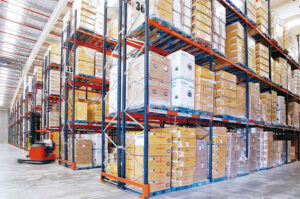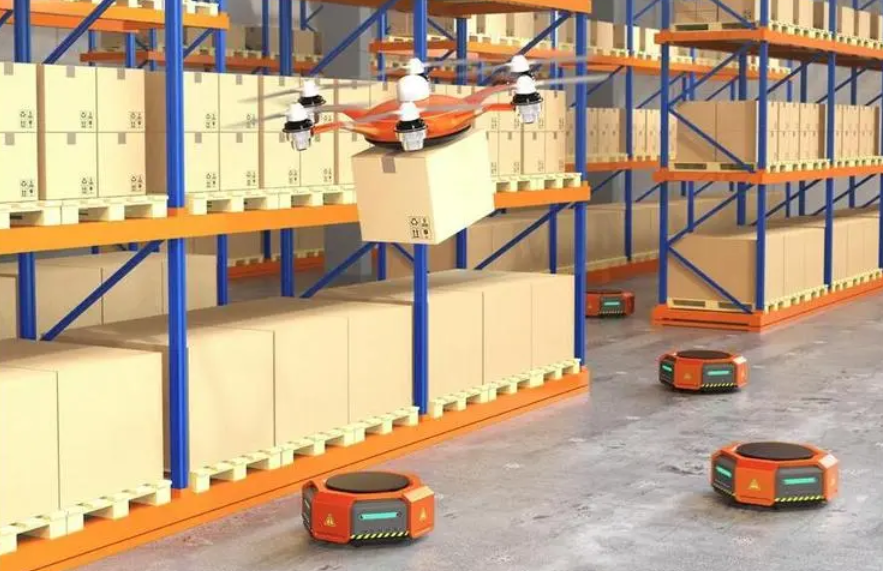The form and characteristics of products determine different storage methods. The products stored in a single piece are generally large products with outer packaging that can be used for shipping. In contrast, those smaller products that need additional packaging are stored in different containers.
Single piece: This is generally a product with its packaging that can be used for shipping or individually packaged. Commonly, single-piece storage is used most often for one-piece-per-order fulfillment.
Box (Package): This type of storage is to put several products in a box, the goods following the unit of the whole box to operate receiving, moving, and inventory. And in this case, the order is fulfilled in full boxes or individual products in boxes. Boxes are mainly used for multiple products that can be moved together at once, generating additional volume and weight, and the cost of the box itself is meager. In operation, boxes/packages are generally removed and scrapped and can not be used twice.
Pallet: This form of storage is a flat wooden or metal platform on which goods are stored so that they can be lifted and moved using a forklift truck.
Depending on the product packaging, the storage of pallets is also different. Some products cannot be stacked and stored after palletizing, but goods with rigid packaging can be stacked and stored after palletizing. Amazon FBA warehouse also has specific size and weight requirements for receiving pallets.
Baskets (Bin): Some products will be scattered in bin baskets, which can be more convenient for individual product handling. This basket is used sparingly for inventory storage; it can only hold a few things like a pallet, and it’s hard to specify how many products are in a box.
Small and large baskets may be used in different scenarios and play different roles. In most warehouses, a Bin is more often used in some temporary scenarios, such as picking baskets or billing.
Warehouse storage management usually requires solving the following three problems.
1. How to operate and move the products, best meet the user’s requirements, and reduce the error rate in the inbound, outbound, and in-store processes.
2. How to retrieve, pick and precisely locate all products and pick the fastest when the order needs to be fulfilled.
3. How to calculate the expense, The expense is mainly for the third-party warehouse, which is the storage fee.
The first two problems combined are what we will explore next.
First, we can divide the inventory management requirements of the warehouse into two simple types refinement and non-refinement.
Refinement is the warehouse can use the correct dimensions (pallets, boxes, pieces) to record the inventory flow of any unit; at any time by sweeping the code or other ways to locate the inventory products, they want to find.
Non-refined management is the warehouse only knows what the product is and how many units (pieces, boxes, pallets) are in a particular warehouse position and can not be pinpointed to a specific product or boxes or pallet.
Some warehouses that do not manage inventory in a fine-grained manner also need to perform fine-grained operations in specific scenarios. For example, when receiving products, you need to scan to the specific box but only specify the type. The same kind of boxes does not need to do more detailed division.

MU stands for Moveable Unit, used in 3PL to solve the first two problems mentioned above. First, let’s take a look at the 3PL definition of MU.
“A movable unit (MU) is a single, identifiable unit load that you can easily track and move.”
MU has two characteristics: individual and recognizable. The purpose of using it is also clear: to make the positioning and handling of products more accessible.
According to this concept, the WMS systems are divided into two categories.
One system has inventory management limited to counting SKUs, cases, and pallets. However, there is no way to scan a pallet label or case label to find its corresponding location.
Another type of system inventory management records the full details of the flow of storage units (MU). It considers necessary when a particular MU moves from one location to another. We can find these details in the system records.
Let’s discuss the handling of fine-grained inventory management by creating MU in pallets as an example.
First of all, MU is a concept used when warehouse management. When we receive goods, we encounter different situations. Such as the following 2 cases. The first is that we receive the goods palletized by the shipper. The following kind is required for the warehouse to palletize the products in the receiving process.
After completing palletizing, you need to stick the pallet label on the pallet, which is very important. This label is the identity card of this pallet, which will have the unique identification code of this pallet and various information about the product. All subsequent operations are to be carried out through this label to locate.
When receiving, by using an APP or PDA, scan the MU tag information and location tag information to tell the system what depot a specific MU has been placed.
The identifiable and retrievable character of the MU dictates that we must handle the MU carefully and keep it correct during its inventory cycle. In other words, we must carefully record every change it makes, including changes in location, splitting, or combining, all of which must be recorded in the system.
When the MU moves, we need to scan and record information about the original location and the MU, as well as the target location. The warehouse operator must feed back this information to the system by scanning or filling in.
If the MU has only half of the products left, another MU has the same situation, and then the warehouse can combine the two MUs and assemble them into a new MU. Of course, this information also needs clear feedback to the system.
Here you will already find that the finely managed warehouse has many things to do with the help of tools: scanners, PDAs, APP, and perhaps robots in the future. These things can help the warehouse record much trivial operational content to meet the requirements of fine-tuned retrieval.
Above, we mentioned two modes of the closure of MU.
The first MU end mode is when the structure of the MU is destroyed. For example, a pallet is dismantled after the pallets are put aside, and the remaining boxes are also re-coded. In this case, the MU as a unit of the pallet certainly no longer exists, even if the scan to the label is meaningless.
Another MU end mode is that some of its products are shipped after the MU is unpacked. The MU is still there, and we can still find it, only it becomes a particular MU. It differs from when the MU was received because the number of products on it has changed. But we can still find it by its label and pick and ship the products on this pallet or combine it with other MUs. In this case, the life cycle of the MU is over once it is combined or the final product is shipped out.
If we are talking about MUs in pallet units, most warehouses use the second type of MU inventory cycle management.
From a business point of view, the handling of MU is different for different businesses. For Freight Outbound (FBA, B2B) picking, the whole MU is handled without unpacking them. When dealing with Parcel Outbound, picking is from single loose pieces to pallets, with loose pieces being the picking priority, followed by unloading pallets. These strategies determine how we determine the order of picking when outbound, how many MUs to take, which MUs to unpack, and how many additional loose boxes to take, all of which require clear recommendations from our picking strategy to facilitate user operation.
When the product is fulfilled, the boxes and pallets for packing are no more extended inventory concepts. However, the packaging containers are for the following transportation section, so we don’t use MU to refer to this situation when we encounter it.
The concept of MU meets the needs of warehouse refinement management and is based on the standard inventory units of the warehouse, like pallets, boxes, baskets, and single products. The warehouse will select different units to create MUs according to product characteristics and operating requirements. Through the tracking of independent and identifiable MUs, the requirements of the warehouse for product retrieval and positioning are realized, thus improving inventory management and meeting higher and more refined needs.

Last updated: 2025-05-06

Last updated: 2025-04-01

Last updated: 2025-03-03

Last updated: 2025-02-05